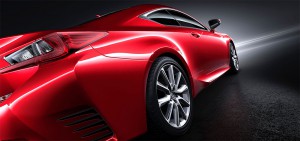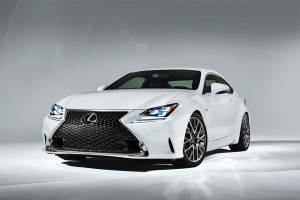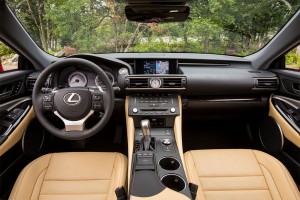Traditionally known for its value and reliability, Lexus has been pushing to broaden its appeal, especially to younger enthusiasts, with a more “passionate” line-up. So it’s betting heavily on the upcoming launch of its new RC Coupe.
More than just a renamed version of the old Lexus IS line, the 2+2 Lexus RC adopts a much more sporty design language – including the most sinister version yet of the brand’s signature “spindle” grille.
It also will feature a new high-performance model that skips the hybrid drivelines Lexus has long favored for a 467-horsepower V-8.
The 2015 Lexus RC could be critical to building momentum for Lexus which has lately regained its position as sales leader in the U.S. luxury car market.
The 2-door model is said to ride on its own chassis, though Lexus acknowledges that it blended the front end of the bigger GS platform with the rear of the IS sport sedan.
Lexus is putting the emphasis on performance with the new RC, rather than fuel economy. Even the “base” RC 350 has some swagger, with a 306-hp 3.5-liter under the hood. In rear-drive versions, that’s paired to an eight-speed Sports Program Direct Shift transmission which, Lexus says, “helps provide smooth acceleration, predictable torque and good fuel economy.”
(Toyota, Lexus taking advanced crash-avoidance technology to the masses. Click Here for the full story.)
The maker will use a 6-speed automatic for the “all-weather-drive” version of the RC 350.
The RC F Sport, meanwhile, replaces the old IS F Sport, picking up on its out-of-character V-8 driveline. The fastest and most powerful Lexus ever – except for the limited-edition LFA supercar – it squeezes a 5.0-liter powertrain under the hood to churn out 467 ponies – enough to put it in competition with some of its toughest German competitors, including the BMW M4.
Lexus suggests the RC design was influenced by the LFA supercar. And it adds some unique styling details for the F Sport model that are meant to both enhance its appearance and increase performance.
The performance coupe also gets rear-wheel steering and a new Adaptive Variable Suspension system, while the Lexus Dynamic Handling system is an optional alternative.
At speeds up to 50 mph, the rear wheels turn the opposite direction of the front wheels to tighten turning and improve cornering. Above 50, the wheels on both axles turn the same direction which, Lexus explains, improves high-speed control and provides a more natural feel through tight corners.
(Luxury makers stretch out with new long-wheelbase models. Click Here for more.)
As for the adaptive suspension, it’s intended to smooth out rough pavement, minimize pitch under hard acceleration and braking, and provide more damping to stabilize the car through a corner.
In keeping with Lexus tradition, the new RC models are loaded with advanced safety features, from their eight airbags to their Pre-Collision and Pre-Collision Brake Assist systems. The latter can not only detect a potential frontal crash but, if necessary, begin applying the brakes automatically. There’s also Blind Spot Monitoring and Rear Cross-Traffic Alert, among other systems.
(Infiniti inspired. Click Here for more on the flagship Infiniti Q80 Inspiration concept.)
There’s the requisite videoscreen for the infotainment system, and a new system now allows a motorist to optionally input information either by voice, on the screen or through a smartphone-like touchpad. The system also adds Clari-Fi, which Lexus claims will improve playback of audio from sources like a smartphone.
Lexus will announce pricing for the two RC models closer to the launch of sales later this year.




Fills in the blanks? There’s nothing new here that hasn’t been previously disclosed by Lexus. I’m waiting for pricing information.